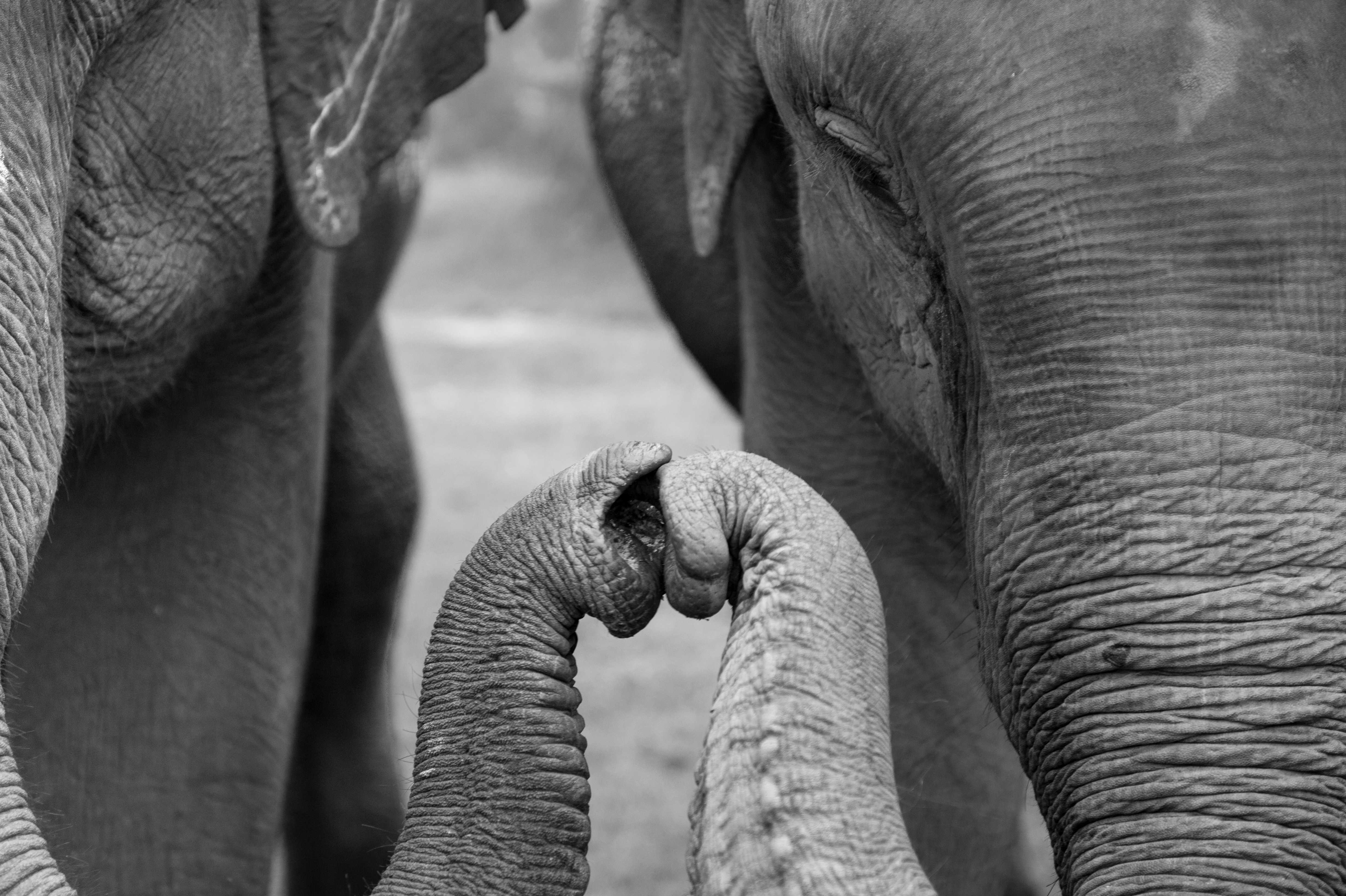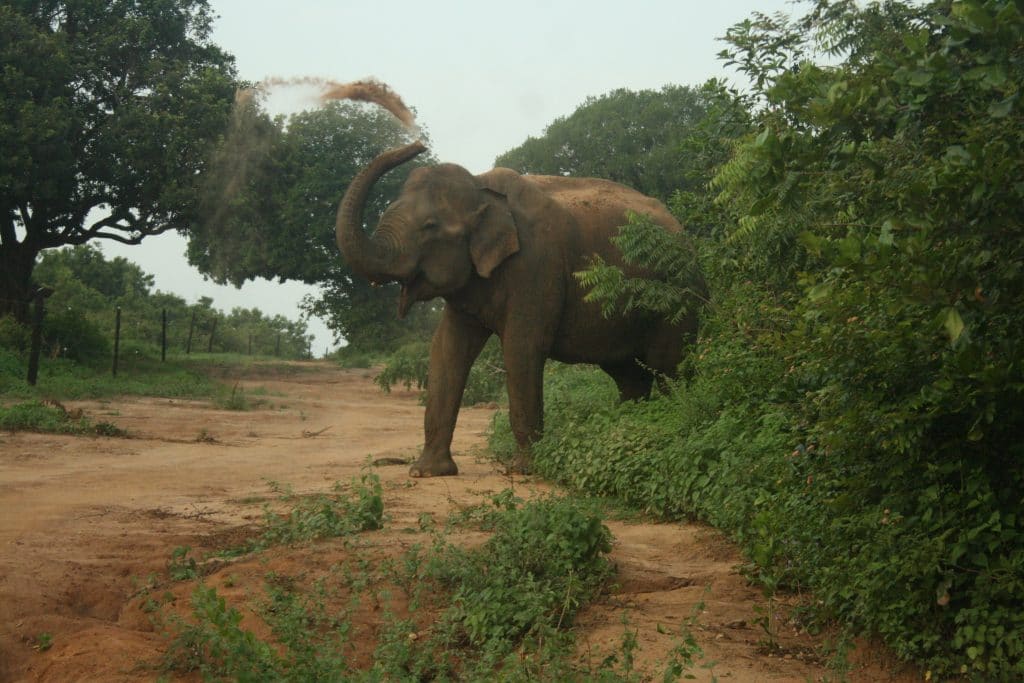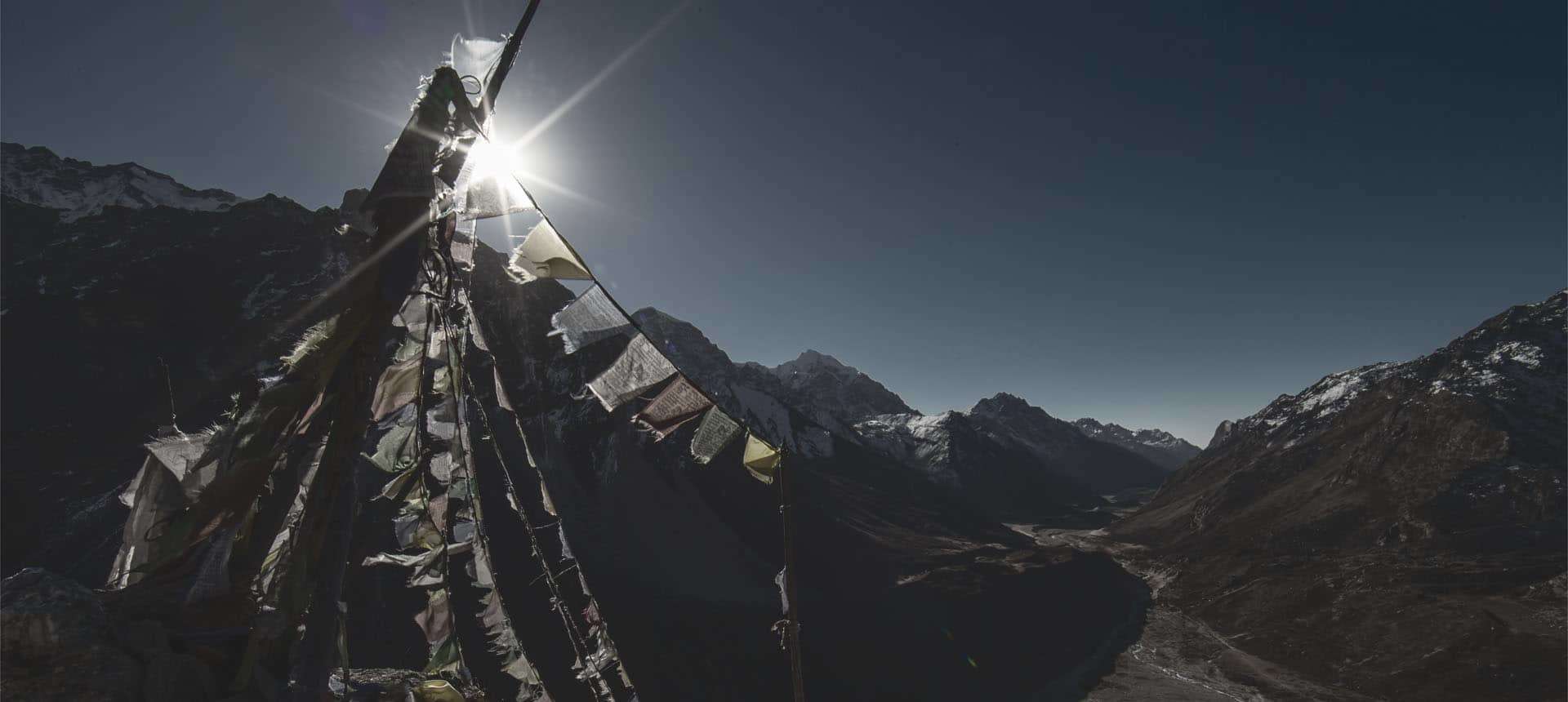
10 Jan Breaking down boundaries with Elemotion
One of the most special aspects of any trip to Sri Lanka is the abundant wildlife. Within a day of arriving most visitors will have ducked under palm trees as monkey’s swing overhead and marveled at the tropical birdlife all around. I remember on my second morning here a five foot monitor lizard casually strolled through the garden of our guesthouse! But to view elephants in their natural habitat, a jeep safari in one Sri Lanka’s 26 national parks is best, and nowhere is better than Udawalawe National Park in the southern heartland. At 800km2 with 1000 associated elephants, Udawalawe has the highest year-round elephant population in the country.
After a slightly unsatisfactory trip to Sri Lanka’s most famous national park, Yala – where we sensed the tourist-rupee was king over conservation and the safari seemed a little aggressive and uncontrolled – we chose Udawalawe because we could connect with local conservation charity, Elemotion. By joining them on a safari, we were offered a firsthand understanding of what an elephant charity actually does, what challenges they face and what success looks like. Elemotion’s charismatic leader Deepani ‘Dee’ Jayantha explained over a pot of Ceylon’s finest, that one of their focuses is to widen the national park’s boundaries as the elephant population here is too dense. Whilst 1,000 elephants in 800km2 is a touristic-dream, it undermines the biggest mammal in Asia’s need for space; a bull in ‘must’ can require 100km to roam. Due to this density, Udawalewe is home to a novel elephant phenomenon: “Bachelor Herds”. Whilst normally living alone, bulls here are herding together (up to 8 at a time) radically changing the sociality of these prehistoric beasts. In a bachelor herd they have been known to mate in teams, causing obvious problems for females.
Two factors are enclosing the elephants: the national park’s political boundary and a flowering plant, Lantana Camara (also known as “Wild Sage”), bought to Sri Lanka during the colonial era from South America that is inedible for elephants, grows aggressively and is replacing elephants natural food sources. So, Dee’s team are inspiring change from the bottom-up, by educating local villages, supporting the park rangers and now empowering tourists to give something back. Elemotions daily work consists of organising bush-clearing programs of Wild Sage with local schools, or planting elephant resistant crops around local villagers. On our journey with them, they are facilitating the first ever park ranger survey. Of course, we’re open to anything and can’t wait to meet the brave men who protect the park and care deeply for this natural environment.
The tour begins at 6am and whilst several other jeeps roar forward as we enter the park, our trusty Elemotion driver, Kumara, shifts hard left and we are completely alone in the wilderness, save the early morning dewy air and the palpable sense of anticipation between the group. As we roll around the western perimeter of the park, the birdlife instantly captivates – tiny bee-eaters buzz from tree to tree, lapwings sprout from the hard ground beneath, and pocket-sized kingfishers always seem to perch side on – so they are instantly recognizable by their iconic long beaks and stylish blue and orange coats. Since being in Sri Lanka I’ve quickly become an amateur ‘twitcher’, and, even a novice like me couldn’t miss, high on a bare wooded branch, the magnificent Serpent Eagle. Silent and surveying, the statuesque figure had no doubt spied us long before we caught a glimpse of it.
Ten minutes in and Kumara cuts the engine. All five of us rise in our seats and see only 20 meters away a large, brooding elephant. We gently crawl the jeep forward, wishing not to disturb but where we can enjoy the view. Dee identifies the elephant as a 35-year-old bull. Of course, he’s well aware of us but pays no attention and continues to chomp down on bush, leaf and twig. Someone in the jeep remarks how contradictory his movements are – at once, balletic and clumsy. We watch as one moment he balances on three legs and itches with the other foot, the next he almost trips on his trunk! A small pang of sadness affects this majestic sight as we notice the elephant is very close to the electric fence. He seemed to be at odds with it, lurching so near it to it he must be wishing it away. Earlier we had learnt that these fences are the very boundaries that Elemotion is looking to break down.
 National Parks are in place to define the areas were wildlife can prosper. Around Udawalawe, electric fences separate the national park from countryside dotted with villages and small farms. Put simply: they limit human-elephant-conflict (HEC) by limiting human-elephant contact. But Elemotion argue that village fences – made from elephant resistance crops or electric fences – are a better model for conservation. That way, elephants have much more freedom to roam. To make sense of the local HEC, Dee explains that it is not that villages don’t like elephants, in fact they love and revere them, but conflict inevitably occurs when crops get ransacked. And how can you blame the elephants she laughs, “Sugar cane are elephant’s favorite food and all the village’s grow sugar… It’s like we’re asking for trouble!” So, it’s about guiding villagers on how to protect their crops. Unlike sugar, elephants do not eat and avoid spices. Therefore sugar cane plantations should be surrounded by black pepper, chilli, turmeric and so on. This new way of thinking is gaining kudos in what Dee declares as a “paradigm shift”. Only now, human settlements, not elephant territories, are being enclosed, in what seems to me to be quite a profound example of progress. Elemotion’s great strides are still only baby-steps in terms of delivery as they need a consistent stream of eco-tourists to help build and maintain the village fences. It strikes me that volunteering with Elemotion is surely the best way to give back and get the most out of a trip to Udawalawe.
National Parks are in place to define the areas were wildlife can prosper. Around Udawalawe, electric fences separate the national park from countryside dotted with villages and small farms. Put simply: they limit human-elephant-conflict (HEC) by limiting human-elephant contact. But Elemotion argue that village fences – made from elephant resistance crops or electric fences – are a better model for conservation. That way, elephants have much more freedom to roam. To make sense of the local HEC, Dee explains that it is not that villages don’t like elephants, in fact they love and revere them, but conflict inevitably occurs when crops get ransacked. And how can you blame the elephants she laughs, “Sugar cane are elephant’s favorite food and all the village’s grow sugar… It’s like we’re asking for trouble!” So, it’s about guiding villagers on how to protect their crops. Unlike sugar, elephants do not eat and avoid spices. Therefore sugar cane plantations should be surrounded by black pepper, chilli, turmeric and so on. This new way of thinking is gaining kudos in what Dee declares as a “paradigm shift”. Only now, human settlements, not elephant territories, are being enclosed, in what seems to me to be quite a profound example of progress. Elemotion’s great strides are still only baby-steps in terms of delivery as they need a consistent stream of eco-tourists to help build and maintain the village fences. It strikes me that volunteering with Elemotion is surely the best way to give back and get the most out of a trip to Udawalawe.
As we continue deeper into Udawalawe the number of elephants keeps on increasing (and we haven’t seen any other jeeps since we left them at the entrance). Next we spot across the plain, two teenage females, gently ruffing the grasses around them with their feet, twirling the shoots with their trunks and neatly tucking the food in their mouths. Dee’s heart fills with joy as she identifies one female as an orphan that Elemotion sponsored at the Elephant Transit Home (ETH). Situated only 5km from the national park’s entrance, the ETH is a must-visit for any trip to Udawalawe. From a viewing platform visitors can watch the 30 young elephants (up to the age of five), being bottle fed. Simply observing their complex social interactions and playtime at the watering holes is a complete joy. Since 1998, 105 recused or orphanage elephants have been rehabilitated and released back into the wild. As we gazed upon one of the healthy females Dee’s team had invested so much into, Dee continued that twelve of the re-released 105 have since given birth in the wild.
Shortly after, we spot three generations of females in a family of four. Admiring from afar, I couldn’t help but anthropomorphize their lives: how their ages and roles are similar to human lifecycles. From watching the baby elephant here (and at the others the orphanage before), I realize that a three year old elephant is exactly that – three years old. Cute, clumsy, dependent on love and attention: basically, a toddler. Similarly, elephant mothers span from late teens to their 40’s and are caring and doting on their young for life, supported by a cast of loving sisters and girlfriends. And when they progress into middle age and grow older, they become extremely sage and authoritative. The grandmother in front of us seemed to almost deliberately turn the other way. But we still had that distinct feeling that she was keeping a keen eye on both her heirs, and us.
By now our ‘ele-count’ is past ten and we start to relax into the rhythm of the safari: the vast open grasslands and the gentle rock of the jeep over clay pools making a heady, seductive dreamland. Now I was being drawn to the smaller details around the jeep: a hare gambling across our path, three jackals skulking up ahead, disappearing into long grass and then reappearing with intent. I appreciate that this place is not just about elephants at all; that Udawalawe is literally teeming with life.
During the third hour of the safari we simply pulled up to watering holes and watched the scene unfold. My girlfriend Flo dubbed one waterhole a “feeding frenzy” as we watched flocks of terns smother the surface and nip at jumping fish. Towards the muddy banks, the long legs of herons and egrets stride through the shallows and neck crabs and other tasty morels. Through the “frenzy”, we also make out 30-odd enormous water buffalo basking neck deep at the far side of the lake, seemingly oblivious to the flocks of birds using their heads and rears as landing zones for their next attack! My most lasting image at one the waterholes was a painted stork standing comically with one wing out-stretched, standing only meters away from a large croc, mouth wide open in the morning sun. It was all very harmonious but on the edge of total destruction. I affectionately remember Dee having her ‘moment’: she simply sighed, “I love this place” whilst murmurations of starlings spun and circled around us. What struck me most about this was how a native Sri Lankan’s most joyous expression was about something so familiar to wildlife back in the UK. It wasn’t something enormous, colourful or loud – like so much of this island’s famous wildlife – but simply beauty in motion. And that’s something to remember when I return home. Wildlife treasures aren’t only the exotic other, but on our doorsteps.
Our day shadowing Elemotion’s daily work gave us firsthand contact with the park’s rangers – the men who commit their lives to allowing this eco-system to thrive. Elemotion were facilitating the first Ranger Survey Programme in Udawalewe (on behalf of the WWF who have commissioned a global study of national park rangers living with elephants). Udawalewe has 20 rangers and these guys are the forgotten heroes of the park’s stability and biodiversity. Stationed at remote points across the park, they commit daily patrols of the landscape, recording animal numbers, aiding the injured and policing illegal activity such a poaching.
Our discussions with the rangers provided us with a wonderful insight into realities of the park (beyond the three hours we saw on safari). One ranger’s heartwarming story described how this week he rescued a baby elephant that had got lost by mistaking water buffalo for it’s herd, and ended up stranded on a cliff edge. Elsewhere, the rangers described that their number one challenge is poachers hunting for bush meat – porcupine, samba, spotted dear, wild boar – as it is their traps that buckle and injure without prejudice. It is this brave but essential daily work that I had never come to consider when visiting wildlife reserves. It was amazing to consider the man-hours of the rangers, alongside the commitment of Dee and her team, that goes into supporting the incredible diversity I saw from the jeep. Elemotion, working alongside ETH and the official national park, are clearly making progress in wildlife conservation and it seems to me that it is only through responsible tourism – and actively supporting grassroots organizations like Elemotion with voluntary hours – that they will continue to breakdown boundaries, build new fences and keep elephant numbers growing.
Craig Ryder





Dean Ryder
Posted at 11:04h, 27 JanuaryGreat insight Craig. Cannot wait to visit SL next week now !!
Paul Bluck
Posted at 09:50h, 28 JanuaryVery interesting article Craig. Lots of things learned in what was a very worthwhile day. Great writing
Tom Westmore
Posted at 12:41h, 28 JanuaryWonderful piece of writing, makes you feel like you were on the trip itself and really highlights the good work that elemotion and other organisations are doing, where do I sign up for my trip!!
Tony Shattell
Posted at 19:55h, 03 FebruarySuperb! We visited Udawalawe and you have captured the place perfectly in this! Takes me back! Beautifully written and insightful!
Lorna Ryder
Posted at 12:40h, 09 MarchNice one Craig you little twitcher! Did the ranger tell you the ending of the story about the baby elephant? Did it make it back to its family?
Christopher Nellist
Posted at 10:48h, 15 JuneThe elephant is the biggest animal on the planet they are great.
Christopher Nellist
Posted at 10:51h, 15 JuneThe elephant is the biggest animal in the world they are great.